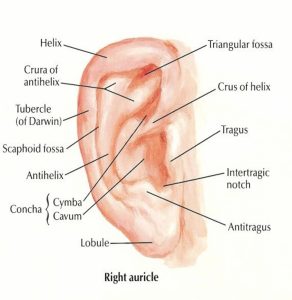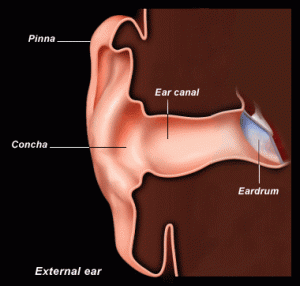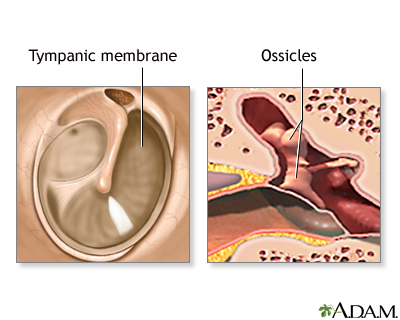4.1.1 Anatomy of the Ear
What is the ear drum?

The ear drum, or “tympanic membrane” is the flexible membrane which is the first point of contact for incoming sounds.
The ear will be described in three parts. The outer ear, consisting of the pinna, and meatus and (outer ear canal), the middle ear, being the air-filled chamber behind the ear drum and finally the fluid-filled inner ear, the cochlea and semi-circular canals.
The Outer Ear

The part of the ear which is seen on the side of the head is called the pinna. The function of this complexly shaped piece of cartilage is to channel and direct the sound into the ear canal in such a way that perception of directionality is enhanced. It is thought that the ridges and crevices of the pinna cause subtle delays or echoes in the sound waves which the brain can interpret to indicate direction of the sound source.
The outer ear canal, the part that can be accessed with a cotton bud, is called the meatus. The canal is about 2.5 centimetres (1 in) in length and 0.7 centimetres (0.3 in) in diameter.
The outer ear canal is slightly curved, and in some people is quite narrow, making it difficult to remove water after swimming.

The skin inside the canal is very sensitive, so it should not be poked with a hard object. Wax is generated in the canal for protection, and will fall out naturally unless it becomes too hard. You should not attempt to clean the canal with a cotton bud, as you are likely to just push the wax in further. It is better to use wax drops to soften the wax, and/or use Sound Therapy.
As sound passes through the meatus the vibrations are detected by branches of the 5th, 7th, 8th and 10th cranial nerves. This means that even before sound reaches the ear drum, the brain is alerted to its approach.
The ear drum (the tympanum) is the flexible membrane at the end of the ear canal, which covers the entrance to the air-filled chamber of the middle ear. It is a cone shaped membrane approximately 10mm (3/8 in) in diameter.

The ear drum, being elastic, can accommodate slight pressure changes. The drum is mounted around its circumference on a bony lip called the tympanic sulcus. The ear drum is formed of three layers. Beginning with the most external they are called cuticular, fibrous and mucous.
There are two main areas to the ear drum, the major region is the pars tensa while the smaller, upper region, which is softer and only consists of two layers, is the pars flaccida.
When doctors or audiologists look into a person’s ear using an otoscope they can see if the eardrum looks healthy, or if there is an obvious problem such as an infection or perforation.

